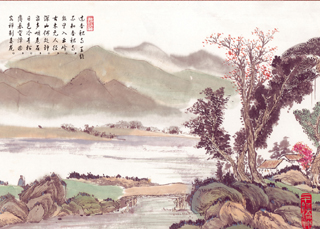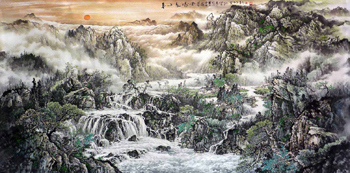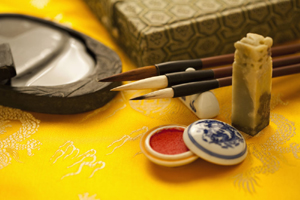
 China Tours
China Tours Tibet Tours
Tibet Tours China Theme Tours
China Theme Tours Off The Beaten Track
Off The Beaten Track Yangtze Cruises
Yangtze Cruises China Trip Planner
China Trip Planner Travel Agents
Travel Agents


We had a wonderful time in Tibet. We have learned a lot about this unique destination because of the wonderful guide Degyi who is so knowledge and always available towards our tours. We stayed at the Shangri-La Hotel Lhasa, and we would never imagine a Tibet travel could be so nice and amazing without the help of Degyi.
Also, thanks a lot to our Tibetan driver Mr.Wongdun for his safe driving and a good sense of service along the way.
We shall return Tibet in the near future!
P.B. and A. A - Europe
Tibet Travel
June 2018 (Private Tibet Journey from Kathmandu)

 Traditional Chinese Painting is highly regarded throughout the world for its theory, expression, and techniques. And it is also one of the oldest continuous artistic traditions in the world. Earliest paintings were ornamental, not representational; they consisted of pattern or designs, not pictures. Traditional Chinese painting is known in Chinese as guo hua, meaning 'national' or 'native painting'.
Traditional Chinese Painting is highly regarded throughout the world for its theory, expression, and techniques. And it is also one of the oldest continuous artistic traditions in the world. Earliest paintings were ornamental, not representational; they consisted of pattern or designs, not pictures. Traditional Chinese painting is known in Chinese as guo hua, meaning 'national' or 'native painting'.The tools used in traditional Chinese painting are paintbrush, ink, traditional paint and special paper (Rice Paper) or silk.
Traditional Chinese painting is done with a brush dipped in black or colored ink. The most popular is that paintings are made of paper and silk. The finished work is then mounted on scrolls, which can be hung or rolled up. Traditional Chinese painting also is done in albums, on walls, and other media.
In its earliest stage, Chinese prehistoric paintings were closely related to other primitive crafts, such as pottery, bronzeware, carved jade and lacquer. The line patterns on unearthed pottery and bronzeware resemble ripples, fishing nets, teeth or frogs. The animal and human figures, succinct and vivid, are proofs to the innate sensitivity of the ancient artists and nature. 
Traditional Chinese painting has its special materials and tools, consisting of brushes, ink and pigments, Xuan paper, silk and various kinds of ink slabs. Chinese painting can be divided into various types based on different classification standards. Taking the subject for example, it can be classified as figure paintings, landscapes and flower-and-bird paintings. Landscapes represent a major category in traditional Chinese painting, mainly depicting the natural scenery of mountains and rivers.
In 1980s Chinese oil painting boomed. Then folk painting came into popular, such as, Chinese New Year pictures. It is pinned up on doors, room walls and windows during New Year to invite heavenly blessings and ward off disasters and evil spirits. Woodcuts have become increasingly diverse in style, theme and artistic form since the early 1980s.
Traditional Chinese painting, poetry, calligraphy, painting and seal engraving are necessary components that supplement and enrich one another. "Painting in poetry and poetry in painting" has been a criterion for excellent works. Inscriptions and seal impressions help explain the painter's ideas and sentiments and also add beauty to the painting.

Chinese calligraphy
Calligraphy is understood in China as the art of writing a good hand with the brush or the study of the rules and techniques of this art. As such it is peculiar to China and the few countries influenced by ancient China culture, for example Japan, South Korea and Vietnam etc.
In the history of Chinese art, calligraphy has always been held in equal importance to painting. Great attention is also paid today to its development by holding exhibitions of ancient and contemporary works and by organizing competitions among youngsters and people from various walks of life. Sharing of experience in this field often makes a feature in Sino-Japanese cultural exchange.
Chinese calligraphy, like the script itself, began with the hieroglyphs and, over the long ages of evolution, has developed various styles and schools, constituting an important part of the heritage of national culture.
Chinese scripts are generally divided into five categories: the seal character (zhuan), the official or clerical script (li), the regular script (kai), the running hand (xing) and the cursive hand (cao).
1) The zhuan script or seal character was the earliest form of writing after the oracle inscriptions, which must have caused great inconvenience because they lacked uniformity and many characters were written in variant forms. The first effort for the unification of writing, it is said, took place during the reign of King Xuan (827-782 B. C.) of the Western Zhou Dynasty, when his taishi (grand historian) Shi Zhou compiled a lexicon of 15 chapters, standardizing Chinese writing under script called zhuan. It is also known as zhouwen after the name of the author. This script, often used in seals, is translated into English as the seal character, or as the "curly script" after the shape of its strokes. Shi Zhou's lexicon (which some thought was written by a later author of the state of Qin) had long been lost, yet it is generally agreed that the inscriptions on the drum-shaped Qin stone blocks were basically of the same style as the old zhuan script. When, in 221 B. C., Emperor Qin Shi Huang unified the whole of China under one central government, he ordered his Prime Minister Li Si to collect and sort out all the different systems of writing hitherto prevalent in different parts of the country in a great effort to unify the written language under one system. What Li did, in effect, was to simplify the ancient zhuan (small seal) script. Today we have a most valuable relic of this ancient writing in the creator Li Si's own hand engraved on a stele standing in the Temple to the God of Taishan Mountain in Shandong Province. The 2,200-year-old stele, worn by age and weather, has only nine and a half characters left on it.
2) The lishu (official script) came in the wake of the xiaozhuan in the same short-lived Qin Dynasty (221 - 207 B. C.). This was because the xiaozhuan, though a simplified form of script, was still too complicated for the scribes in the various government offices who had to copy an increasing amount of documents. Cheng Miao, a prison warden, made a further simplification of the xiaozhuan, changing the curly strokes into straight and angular ones and thus making writing much easier. A further step away from the pictographs, it was named lishu because li in classical Chinese meant "clerk" or "scribe". Another version says that Cheng Miao, because of certain offence, became a prisoner and slave himself; as the ancients also called bound slaves "li", so the script was named lishu or the "script of a slave".
3) The lishu was already very close to, and led to the adoption of, kaishu, regular script. The oldest existing example of this dates from the Wei (220-265), and the script developed under the Jin (265-420). The standard writing today is square in form, non-cursive and architectural in style. The characters are composed of a number of strokes out of a total of eight kinds-the dot, the horizontal, the vertical, the hook, the rising, the left-falling (short and long) and the right-falling strokes. Any aspirant for the status of calligrapher must start by learning to write a good hand in kaishu.
4) On the basis of lishu also evolved caoshu (grass writing or cursive hand), which is rapid and used for making quick but rough copies. This style is subdivided into two schools: zhangcao and jincao. The first of these emerged at the time the Qin was replaced by the Han Dynasty between the 3rd and 2nd centuries B. C. The characters, though written rapidly, still stand separate one from another and the dots are not linked up with other strokes. Jincao or the modern cursive hand is said to have been developed by Zhang Zhi (?-c. 192 A. D.) of the Eastern Han Dynasty, flourished in the Jin and Tang dynasties and is still widely popular today. It is the essence of the caoshu, especially jincao, that the characters are executed swiftly with the strokes running together. The characters are often joined up, with the last stroke of the first merging into the initial stroke of the next. They also vary in size in the same piece of writing, all seemingly dictated by the whims of the writer. A great master at caoshu was Zhang Xu (early 8th century) of the Tang Dynasty, noted for the complete abandon with which he applied the brush. It is said that he would not set about writing until he had got drunk. This he did, allowing the brush to "gallop" across the paper, curling, twisting or meandering in one unbroken stroke, thus creating an original style. Today one may still see fragments of a stele carved with characters in his handwriting, kept in the Provincial Museum of Shaanxi.
5) The xingshu or running hand is something between the regular and the cursive scripts. When carefully written with distinguishable strokes, the xingshu characters will be very close to the regular style; when swiftly executed, they will approach the caoshu or cursive hand. Chinese masters have always compared with vivid aptness the three styles of writing-kaishu, xingshu and caoshu-to people standing, walking and running. The best example and model for xingshu, all Chinese calligraphers will agree, is the Inscription on Lanting Pavilion in the hand of Wang Xizhi (321-379) of the Eastern Jin Dynasty. To learn to write a nice hand in Chinese calligraphy, assiduous and persevering practice is necessary. This has been borne out by the many great masters China has produced. Wang Xizhi, the great artist just mentioned, who has exerted a profound influence on, and has been held in high esteem by, calligraphers and scholars throughout history, is said to have blackened in his childhood all the water of a pond in front of his house by washing the writing implements in it after his daily exercises. Another master, Monk Zhiyong of the Sui Dynasty (581- 618) was so industrious in learning calligraphy that he filled many jars with worn-out writing brushes, which he buried in a "tomb of brushes". 
The Four Treasures of the Study (Wenfang Sibao)
The writing brush, ink stick, paper and ink slab are the traditional implements and materials for writing and painting and have always been named collectively as the "four treasure of the study".
Writing Brush may date back to at least three thousand years ago. It is made from fine, soft animal hair including three types: the white goat hair, black rabbit hair and yellow weasel hair. The brush handle can be made of bamboo, wood, lacquer, porcelain or some precious materials, mother-of-pearl inlay, ivory, and jade. Usually, painters and calligraphers have several types of brushes on hand to adapt to individual purposes and preferences.
Ink stick, initially, people often generally use nature ink or half-nature ink. In the Han Dynasty, the artificial ink appeared. It is made from a mixture of soot and resin and raw materials were pine, oil and lacquer. Ink sticks can be regarded as ink in solid state. Getting ink from the hard ink stick requires some physical labor, so ancient Chinese calligraphers had young boy attendants help them with this task. The procedure is like this: firstly, the ink stick is rubbed against the ink slab to generate ink powder; secondly, water is added to the ink powder to form the ink. One advantage of doing so is that you can easily adjust the density of the ink by changing the amount of water or ink powder.
Paper is one of the most famous Chinese inventions and was invented by Cai Lun in the Eastern Han Dynasty. Then traditional bamboo slips and silk are replaced by the paper. The most famous paper used for Chinese calligraphy and Chinese painting is rice paper, also named as Xuan paper.
Ink Slab is the container used in Chinese calligraphy and painting for grinding dry ink (ink stick) and mixing it with water. Most of ink slabs are made of stone, but other materials, such as, pottery, brick and tile. The stone must be relatively fine whetstone in order to protect the bristles of the brush and to facilitate the grinding of the ink stick. Thus ink and the ink slab acts as an inkwell. In ancient times, artisans would have their names or other words engraved on their ink slab that would be passed on to future generations.
China Trip Planner | Travel Agents | About Us | Why Us | Contact Us | How to Pay | How to Book - Terms & Conditions | Site Map
Copyright © 2010 - 2030 All Rights Reserved.


 0086-28-85711328
0086-28-85711328 0086-28-85546015
0086-28-85546015



